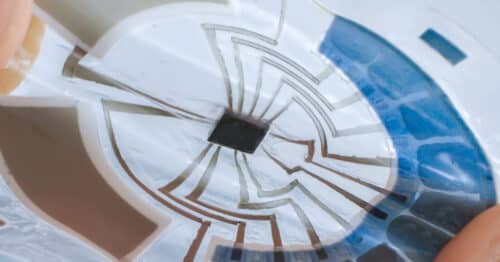Researchers from the University of California San Diego have invented a thin, flexible and stretchy sweat sensor that could trace levels of glucose, lactate, sodium, or pH of your sweat, at the press of a finger

Currently, India ranks second in the global diabetes epidemic which makes it necessary for providing instant diagnosis and treatment. It is not practical to use wearable devices for measuring health parameters due to their inefficiency. Hence, engineers from San Diego have developed a standalone wearable device with a display that enables the sensor to work autonomously without any wired or wireless connection to external devices. The measurements of glucose, lactate, sodium, or pH of your sweat are displayed directly.
“We are trying to address the issue of practicality in wearable technologies,” said co-first author Lu Yin, a nanoengineering postdoctoral researcher at the UC San Diego Jacobs School of Engineering. “We have seen so many inventions of wearable sensors with great novelty but with limited practicality.”
The novel design of this small disk-shaped patch includes all the essential components that are required for wearable sensors: two integrated batteries, a microcontroller, sensors, the circuit, and a stretchable display. All the components and interconnections, except the microcontroller, are configured using customized elastomeric inks, which can be printed using low-cost and high-throughput screen printing onto stretchable polymer sheets.
The device is fabricated with the formulation of nine types of different stretchable inks, which were used to print the batteries, circuits, display panels, and sensors. The device is printed layer-by-layer onto stretchable polymer sheets and then assembled with hydrogels and microcontroller chips into the complete device. Each ink was optimized to ensure its compatibility with other layers while balancing its electrical, chemical, and mechanical performance.
The patch can be stretched 20% repeatedly without affecting its performance. The researchers have developed a special type of non-light-emitting display to trace the data from the sensors. The electrochromic display technology uses materials that change color upon applying an electrical pulse, which has very low power consumption. The researchers designed a display panel composed of 10 individual pixels, which is programmed to display the concentration of the chemicals by turning on different numbers of pixels. The display can rapidly change color to visualize the sweat lactate concentration. This device is experimented with by the researchers, they stress-tested each component of the system, so that the display, sensors, and batteries can be stretched for up to 20% over 1500 cycles with little to no effects on their performance. The batteries were also packed with enough power to make sure the patch can last over a week of non-stop usage.
“Adding the flexible display and stretchable battery has a tremendous impact toward practical epidermal microscale sensing platforms,” said UC San Diego nanoengineering professor Joseph Wang. He is a senior author of the new paper and co-director of the UC San Diego Center for Wearable Sensors.
The researchers aim to develop a more advanced version of the integrated sensor that will consist of a rechargeable battery and will be able to harvest energy from the body. This will extend the lifetime of the wearable patch.
Click here for the Published Research Paper






